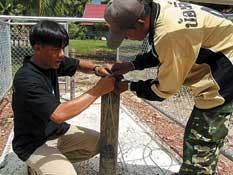Sealed data loggers monitor groundwater level trends in Thailand
By Craig Mckee
Farmers in rural Thailand rely on groundwater for irrigation and aquaculture; however gaining access to fresh groundwater is difficult due to the lack of technology and increasing saltwater contamination from shrimp farming and saltwater intrusion.
King Phumiphon Adunyadet of Thailand recognised this problem, so he helped devise a plan to implement and fund a programme to determine pumping capacity and trends in groundwater levels through monitoring. He assigned the task of site determination and the development of a monitoring programme to the Thailand Department of Mineral Resources. The department chose miniTROLL dataloggers, developed by the US company In-Situ, to gather data from pumping tests.
Fifteen mini-TROLLS were installed in November 2002 in the Pakpanang District, located 900 kilometres south of Bangkok. In 2001, 24 miniTROLLS were also installed in the northern part of the country. Since potential flooding poses a serious problem, the ministry selected the Standard-A miniTROLL with a non-vented or "absolute" sensor and a sealed backshell. Rain can fall continuously in this part of the country from October to March.
Since the mini-TROLL contains sensors, a datalogger and internal power, the unit can be completely sealed from the atmosphere using a stainless steel backshell. No external connections are required and steel cable or other suitable materials suspend the unit.
At one site, three units were installed in close proximity at varying depth. Typically, the depth to the water table fluctuates from 1.5m to 10m, while the depth of installation for mini-TROLLS ranges from 10m to 15m. The depths of each well can range up to 200m and greater.
Steel cable suspends the miniTROLLS rather than vented cable, which incorporate a vent tube connecting the backside of the pressure sensor to the atmosphere to prevent flooding of the unit via the vent tube. When using an absolute sensor, fluctuations in pressure readings can occur due to changes in the barometric pressure causing errors in the readings of the true water level. Data from a separate barometric sensor or Baro-TROLL can be used to remove the barometric readings in the water level readings. The BaroWizard utility provided from the Win-Situ software will then automatically correct the water level data by removing the barometric pressure readings supplied by the BaroTROLL. If a BaroTROLL is not used, the barometric pressure obtained from a local weather bureau can be manually entered into the software to correct the data. The BaroTROLL is usually installed inside of the well casing at the top so that it is hidden from the surface.
After installation, step drawdown pumping tests were performed to determine the effects of pumping on the water table and the capacity of each site. Pumping and slug tests are commonly used to determine the properties of an aquifer such as the Hydraulic Conductivity, Transmissivity, Specific Yield and Storage Coefficient. Such tests can last from days to months. After the step drawdown pumping tests are completed, the units are left to collect long-term water level data that will be used to track long-term water level trends. Data is collected every three to six months and analysed, since each site can be located hundreds of kilometres from Bangkok. To collect the data, the miniTROLL is removed from the well and data is downloaded using a Pocket PC and Pocket-Situ software.
Heavy rains completely flooded the site shortly after installation; however the site and miniTROLL were unaffected due to the site design and the sealed miniTROLLS.
Author's NoteCraig McKee is the vice president of In-Situ, Inc., based in Laramie, Wyoming, USA. Siripong Sithiburana of Survey Engineering Ltd. Partnership, Thailand, provided information and illustrations for this article.





